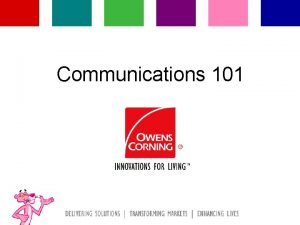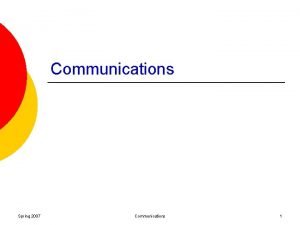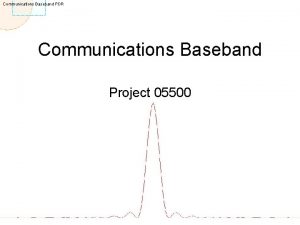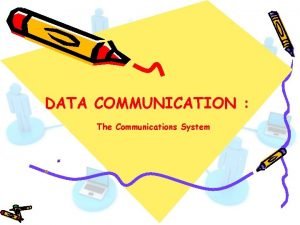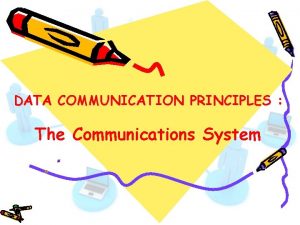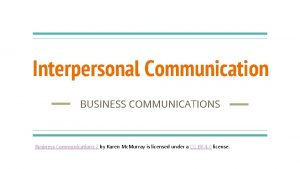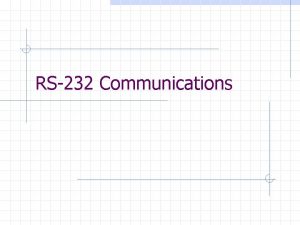Ag Communications One to One Communication One to

























- Slides: 25

Ag Communications One to One Communication

One to One Communication l Communicating with one other person

One to One Communication l Face to Face Conversations l Telephone Calls l Interviews

Verbal Aspects l Conversation- talking about various matters of interest to both parties, these are usually not planned or rehearsed beforehand

Conversation

How to Improve Conversation 1. Send and Receive Message Accurately- always give careful thought to what you say, make sure it is in words your receiver will understand, rephrase if your listener doesn’t get your drift, and always listen effectively

How to Improve Conversation 2. Be Courteous- take turns, don’t interrupt to insert your own ideas, avoid verbally attacking someone when you disagree with what they are saying, and always try to remain open minded

How to Improve Conversation 3. Be able to Speak on a Number of topics- try to develop a variety of interests, don’t jump from one topic to another without transition, be sure to allow the other person in the conversation to speak about their interests as well

How to Improve Conversation 4. Learn to Enjoy Conversationalways try to speak with enthusiasm and dynamics and attempt to make the conversation enjoyable for everyone. Conversation is one of life’s most pleasant means of teaching and learning

Non Verbal Aspects 1. Kinesics. Use of Body Motion; eye contact, facial expressions, length of time you maintain eye contact

Non Verbal Aspects l Understanding non-verbal aspects is essential because over 50% of a messages impact comes from body language • 7%- Verbal (Words) • 38%- Vocal (Volume, Pitch, Tone, etc. ) • 55%- Body Language (Kinesics & Proxemics)

Kinesics A. Eye Contact- authority demands eye contact, not making eye contact can give a negative impression- lying, lack of respect, lack of focus etc. 1. Avoid Extremes- avoid making too much or too little eye contact

Kinesics B. Facial Expressionsshow interest, anger, disappointment, fear, sadness, etc.

Facial Expression • Awareness- be aware of your facial expressions during conversation, they convey your mood

Kinesics C. Arm- Hand Movement – describe, locate, symbolize and explain • Avoid extremes- lack of movement suggests disinterest, too much movement can be distracting- be natural

Non Verbal Aspects 2. Proxemics- Using space, avoid invading personal space a. Friends and Family- allow closeness, most allow touch, hugs etc.

Proxemics l General Spatial Comfort Zone • Intimate- (0 -18”) • Personal- (1. 5’-4’) • Social- (4’-12’) • Public- (12’-20’)

Proxemics b. Acquaintances- Being too close may cause discomfortyou may put up barriers

Non Verbal Aspects 3. Time- amounts of time spent tell us much l More time means more important

Time • Allowing many interruptions signals feelings of unimportance

Non Verbal Aspects 4. Appearanceneatness and being well groomed- smell good, clothing is clean and neat, hair is brushed and styled

Appearance l. You can’t get a first impression back- we can control cleanliness and neatness- we may have to overcome impressions about height, weight, or other stereotypes

Non Verbal Aspects 5. Paralanguage - use of rate, tone, etc. : voice - can convey messages about mood or attitude

Paralanguage 1. Vocalized Pausesoveruse can send negative messageslying or stupidity

What Messages are YOU Sending? l Are you aware of : • Your expressions? • Your cleanliness? • Your tone? • Your proxemity? • Your timing • Words and meanings behind them?
 One-stop service for communication
One-stop service for communication Communication cycle argyle
Communication cycle argyle Parallel and serial communication
Parallel and serial communication What is oral communication and written communication
What is oral communication and written communication Parallel communication in 8051
Parallel communication in 8051 Types of nonverbal communication chronemics
Types of nonverbal communication chronemics Definition of oral communication
Definition of oral communication Serial communication vs parallel communication
Serial communication vs parallel communication One empire one god one emperor
One empire one god one emperor One one one little dogs run
One one one little dogs run One king one law one faith
One king one law one faith Byzantine definition
Byzantine definition Ford one plan
Ford one plan See one do one teach one
See one do one teach one One price policy
One price policy One face one voice one habit and two persons
One face one voice one habit and two persons See one do one teach one
See one do one teach one Asean tourism strategic plan
Asean tourism strategic plan One vision one identity one community
One vision one identity one community Crisis communication working group
Crisis communication working group Tfc t10 coaxial cable
Tfc t10 coaxial cable Nims communications and information management
Nims communications and information management Advantages of star topology
Advantages of star topology Voice communication army
Voice communication army Perform voice communications army powerpoint
Perform voice communications army powerpoint Communications mix
Communications mix


























